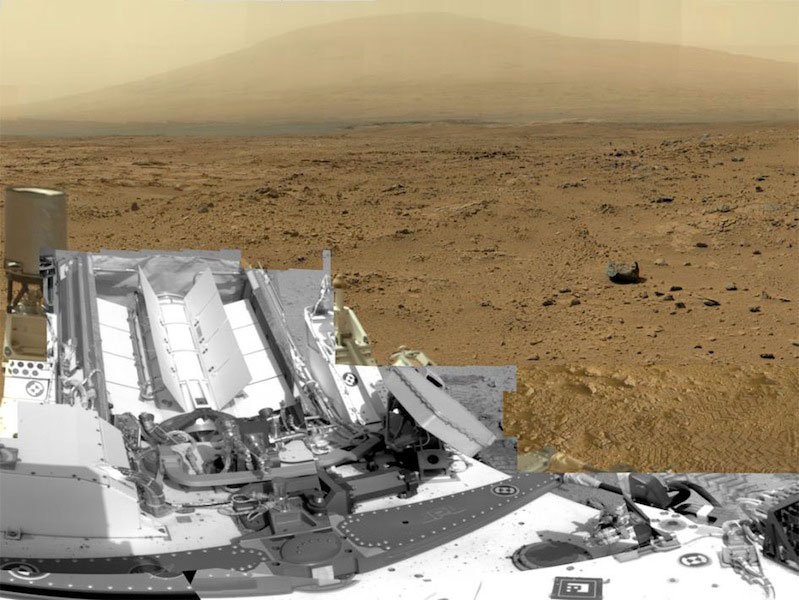This full-circle view combined nearly 900 images taken by NASA’s Curiosity Mars rover, generating a panorama with 1.3 billion pixels in the full-resolution version. The view is centered toward the south, with north at both ends. It shows Curiosity at the “Rocknest” site where the rover scooped up samples of windblown dust and sand. Curiosity used three cameras to take the component images on several different days between Oct. 5 and Nov. 16, 2012.
Viewers can explore this image with pan and zoom controls at http://mars.nasa.gov/bp1/.
This first NASA-produced gigapixel image from the surface of Mars is a mosaic using 850 frames from the telephoto camera of Curiosity’s Mast Camera instrument, supplemented with 21 frames from the Mastcam’s wider-angle camera and 25 black-and-white frames–mostly of the rover itself–from the Navigation Camera. It was produced by the Multiple-Mission Image Processing Laboratory at NASA’s Jet Propulsion Laboratory, Pasadena, Calif.
This version of the panorama retains “raw” color, as seen by the camera on Mars under Mars lighting conditions. A white-balanced version is available at http://photojournal.jpl.nasa.gov/catalog/PIA16918. The view shows illumination effects from variations in the time of day for pieces of the mosaic. It also shows variations in the clarity of the atmosphere due to variable dustiness during the month while the images were acquired.
A billion-pixel view from the surface of Mars, from NASA’s Mars rover Curiosity, offers armchair explorers a way to examine one part of the Red Planet in great detail.
The first NASA-produced view from the surface of Mars larger than one billion pixels stitches together nearly 900 exposures taken by cameras onboard Curiosity and shows details of the landscape along the rover’s route.
The 1.3-billion-pixel image is available for perusal with pan and zoom tools at: http://mars.nasa.gov/bp1/.
The full-circle scene surrounds the site where Curiosity collected its first scoops of dusty sand at a windblown patch called “Rocknest,” and extends to Mount Sharp on the horizon.
“It gives a sense of place and really shows off the cameras’ capabilities,” said Bob Deen of the Multi-Mission Image Processing Laboratory at NASA’s Jet Propulsion Laboratory, Pasadena, Calif. “You can see the context and also zoom in to see very fine details.”
The latest Mars Curiosity Rover report, from June 7, on developments and status of the planetary exploration mission. Curiosity carries 10 science instruments with a total mass 15 times as large as the science payloads on NASA’s Mars rovers Spirit and Opportunity. Some of the tools, such as a laser-firing instrument for checking rocks’ elemental composition from a distance, are the first of their kind on Mars. Curiosity will use a drill and scoop, which are located at the end of its robotic arm, to gather soil and powdered samples of rock interiors, then sieve and parcel out these samples into the rover’s analytical laboratory instruments.
Deen assembled the product using 850 frames from the telephoto camera of Curiosity’s Mast Camera instrument, supplemented with 21 frames from the Mastcam’s wider-angle camera and 25 black-and-white frames–mostly of the rover itself–from the Navigation Camera. The images were taken on several different Mars days between Oct. 5 and Nov. 16, 2012. Raw single-frame images received from Curiosity are promptly posted on a public website at: http://mars.jpl.nasa.gov/msl/multimedia/raw/. Mars fans worldwide have used those images to assemble mosaic views, including at least one gigapixel scene.
The new mosaic from NASA shows illumination effects from variations in the time of day for pieces of the mosaic. It also shows variations in the clarity of the atmosphere due to variable dustiness during the month while the images were acquired.
NASA’s Mars Science Laboratory project is using Curiosity and the rover’s 10 science instruments to investigate the environmental history within Gale Crater, a location where the project has found that conditions were long ago favorable for microbial life.
Malin Space Science Systems, San Diego, built and operates Curiosity’s Mastcam. JPL, a division of the California Institute of Technology in Pasadena, manages the project for NASA’s Science Mission Directorate in Washington and built the Navigation Camera and the rover.
More information about the mission is online at: http://www.nasa.gov/mission_pages/msl/index.html and http://mars.jpl.nasa.gov/msl/.
You can follow the mission on Facebook and Twitter at: http://www.facebook.com/marscuriosity and http://www.twitter.com/marscuriosity.
For more information about the Multi-Mission Image Processing Laboratory, see: http://www-mipl.jpl.nasa.gov/mipex.html.
News courtesy NASA.gov.



